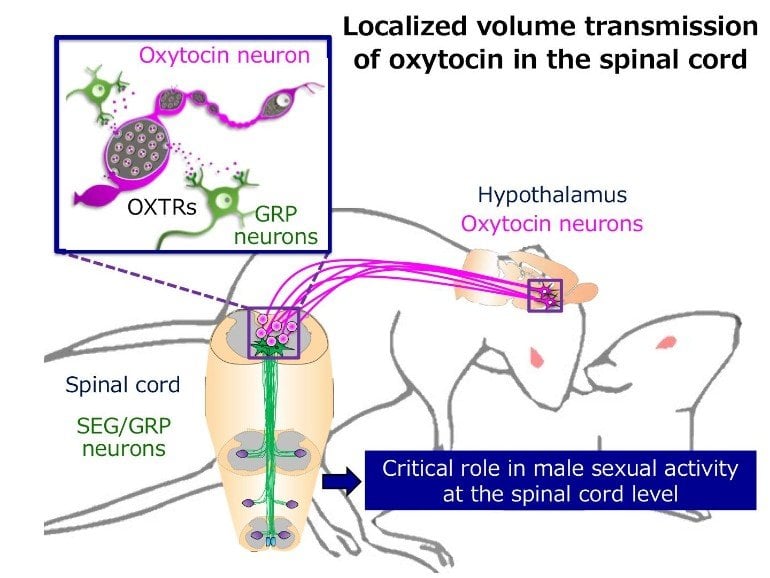Summary: Oxytocin injections in rodent models directly activated SEG/GRP neurons via oxytocin receptors and influenced male sexual functions in the lumbar spinal cord. Reducing the activity of oxytocin receptors resulted in a decrease in sexual activity and ejaculatory response in the animals.
Source: Okayama University
Hormones are key players of the endocrine system and have a major influence on our emotional and sexual wellbeing. The hormone oxytocin is involved in a wide range of emotions from social bonding to maternal behaviors like nursing and lactation. But the most popular and well-known role of oxytocin, lending it its popular moniker of ‘love hormone,’ is its role in romantic and sexual emotions.
The functional mechanism of oxytocin in male sexual function and behavior is not clearly understood, but there is some evidence supporting the role of oxytocin-specific nerve cells or neurons in the brain that project to the lower spinal cord and control penile erection and ejaculation in male rats.
Now, in a brand new study published in Current Biology, a group of researchers led by Professor Hirotaka Sakamoto from Okayama University, Japan, has explored this potential role of oxytocin and the underlying mechanisms in modulating male sexual function using rats as a model system.
Oxytocin is transferred from the brain to various parts of the body by the blood, and from neuron to neuron through structures called “synapses.” However, the precise mechanisms by which sparsely dispersed oxytocin fibers–structures responsible for responding to oxytocin in the central nervous system–cause the activation of widely distributed receptors remain unclear.
The researchers from Japan investigated a novel non-synaptic mode of oxytocin transport across the central nervous system. When asked to explain this process, Prof Sakamoto refers to an interesting analogy:
“Overall, the endocrine system, which acts on widespread distant organs via the circulation, resembles a ‘broadcasting satellite’ communication, whereas synaptic transmission resembles the hard-wired ‘ethernet.’ Accordingly, the localized volume transmission of peptides resembles ‘Wi-Fi’ communication, since it is a hybrid of both endocrine (satellite) and synaptic (ethernet) systems, and may be the predominant mechanism of oxytocinergic modulation of socio-sexual behavior and cognition throughout the central nervous system.”
It is already known that spinal regions like the spinal ejaculation generator (SEG) are known to control sexual functions in male rodents. To assess the role of oxytocin in copulatory and ejaculatory responses, the team injected oxytocin into the spine of male rats. The gastrin-releasing peptide or GRP neurons are an important component of the SEG, as they control the lower lumbar region connected to muscles at the base of the penis, thereby controlling erection and ejaculation.
Oxytocin caused an increased sexual activity and neuronal activity in injected animals. More specifically, oxytocin was found to directly activate SEG/GRP neurons via oxytocin receptors, which detect oxytocin, and influence male sexual function in the rat lumbar spinal cord. Using an oxytocin receptor antagonist, which reduces the activity of oxytocin receptors, resulted in a latency and decrease in number of sexual activity and ejaculatory responses in majority of the animals, confirming the importance of oxytocin.

The question remained about the transport of oxytocin, however. Electron microscopy images acquired from slices of the lumbar region ruled out the presence of synaptic vesicles or connections. Upon stimulation of exocytosis ex-vivo, they were able to observe oxytocin transport mediated by a more passive diffusion in extracellular spaces at non-synaptic sites.
Highlighting the importance of the study, Prof Sakamoto remarks, “Now that we have uncovered a novel neural mechanism-the ‘localized volume transmission’ of oxytocin from axons-involved in controlling male sexual function in the spinal cord, we can hope that this may lead to the development of treatments for male sexual dysfunction.”
This study thus presents a completely unprecedented role for oxytocin in male sexual function, in addition to its long-standing “female-centric” role. Learning more about this “love hormone” may indeed help us foster healthier and long-lasting loving relationships!
About this neuroscience research news
Source: Okayama University
Contact: Hirotaka Sakamoto – Okayama University
Image: The image is credited to Okayama University
Original Research: Open access.
“Oxytocin Influences Male Sexual Activity via Non-synaptic Axonal Release in the Spinal Cord” by Sakamoto et al. Current Biology
Abstract
Oxytocin Influences Male Sexual Activity via Non-synaptic Axonal Release in the Spinal Cord
Highlights
- •Oxytocin receptors are expressed in spinal ejaculation generator (SEG) neurons
- •Oxytocin directly activates SEG neurons and influences male sexual function in rats
- •Release of oxytocin in the lumbar spinal cord is not limited to conventional synapses
- •Released oxytocin acts by diffusion—a localized volume transmission—in the cord
Summary
Oxytocinergic neurons in the paraventricular nucleus of the hypothalamus that project to extrahypothalamic brain areas and the lumbar spinal cord play an important role in the control of erectile function and male sexual behavior in mammals. The gastrin-releasing peptide (GRP) system in the lumbosacral spinal cord is an important component of the neural circuits that control penile reflexes in rats, circuits that are commonly referred to as the “spinal ejaculation generator (SEG).” We have examined the functional interaction between the SEG neurons and the hypothalamo-spinal oxytocin system in rats. Here, we show that SEG/GRP neurons express oxytocin receptors and are activated by oxytocin during male sexual behavior. Intrathecal injection of oxytocin receptor antagonist not only attenuates ejaculation but also affects pre-ejaculatory behavior during normal sexual activity. Electron microscopy of potassium-stimulated acute slices of the lumbar cord showed that oxytocin-neurophysin-immunoreactivity was detected in large numbers of neurosecretory dense-cored vesicles, many of which are located close to the plasmalemma of axonal varicosities in which no electron-lucent microvesicles or synaptic membrane thickenings were visible. These results suggested that, in rats, release of oxytocin in the lumbar spinal cord is not limited to conventional synapses but occurs by exocytosis of the dense-cored vesicles from axonal varicosities and acts by diffusion—a localized volume transmission—to reach oxytocin receptors on GRP neurons and facilitate male sexual function.







